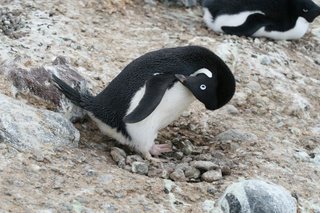Back From the Antarctic Void
We’re back! Our internet has been fixed for a week and we’re busier than ever, so I have had very little time to post. We’re in the peak of our field season right now, and we seem to have barely any time left after sleeping, eating, collecting and entering data. No time to read, barely any time to ski (Grant has gone twice), and very little time for writing, which is one of my favorite things to do here. I am taking lots of photos though – I can’t give that up no matter how busy I am.
I was at Cape Royds for about 5 days at the end of November and then flew back to Cape Crozier, where there are currently five of us: Amélie, Valère, Grant, Ian, and myself. Ian is mostly working on the documentary, filming penguins and seals and ice for several hours a day. The rest of us are busy resighting banded birds (we have over 700 and counting), tracking nests, attaching transmitters, and working on our various projects: Amélie is working on her postdoc, Grant and I on our graduate projects, and Valère is busy keeping track of a large portion of the banded nests.
Big things that happened so far: Ian arrived in early December, bringing the camp population to 5, which is about as much as this little hut can handle. We all sleep in tents and use the hut only for cooking and running computers, but it’s still pretty tight in here. During storms we generally abandon the tents for fear that they will blow away, but we have yet to have any serious storms since Ian’s arrival. The chicks started hatching about three days earlier than usual, around December 6th, and they are growing fast! It seems that with the iceberg gone the penguins are having a much easier time finding food and feeding their chicks. They are fat and peeping and growing and their stomachs are taut and full of krill and fish.
Our species list to date includes (in more or less order of abundance) Adélie penguins, south polar skuas, emperor penguins, Weddell seals, orcas, snow petrels, minke whales, leopard seals, Antarctic petrels, crabeater seals, Wilson’s storm petrels, and a few unidentified whales (probably beaked). There is much more under water, but this is what we can see from our terrestrial vantage point. A short and amazing list of creatures who have adapted to one of the harshest climates on earth.
It's 2AM now and I am exhausted, so I'll leave this with a few favorite photos from the past three weeks. More soon.

An Adélie penguin giving me the "bill-to-axilla" display (a territorial statement)

A bad-ass penguin. Adélie penguins can growl quite well - this one was very good at it and nearly attacked me as I tried to squeeze by.

The all-black penguin (the only one we know of) has black-and-white mate!

A south polar skua with its chick.

Wave clouds on the horizon.

An emperor penguins checking out Grant's filming techniques

Me. Self-portrait at Cape Royds.

Amelie holding down the boxes on the helicopter pad.

Valere smiling at the view upon arriving at Cape Crozier (note our orange hut in the background).

2 Comments:
Wave clouds, cool. Is that a coincidence or is there really such a thing as a wave cloud?
Am happy that the all black adelie found a mate. It’s not so bad standing out from the crowd after all.
I have never heard of a wave-cloud before, but that's definitely what I saw out there in the clouds along the horizon...little waves moving north in the sky.
The black penguin is my favorite. It's always a visual shock to see it in a colony of 250,000 black and white penguins (well, there are a few blond-and-white, but they are a little bit more common). Even though I expect to see her in the same spot every year I always do a double-take when I actually see her.
Post a Comment
<< Home